English Study
> Jmeade43
Notes for Grammar. Helping Student Writers Find the Best Evidence. By Sarah Tantillo No matter what grade or subject you teach, sooner or later you find yourself trying to help students write more clearly and convincingly.

North Jersey schools look for creative responses to Common Core - NJ State News. As Common Core standards have rolled out in New Jersey schools, one standard in particular has challenged the thinking of local educators, academics and administrators: the heavy reliance on informational texts, such as science books.
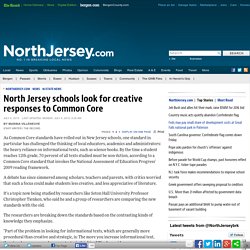
By the time a student reaches 12th grade, 70 percent of all texts studied must be non-fiction, according to a Common Core standard that invokes the National Assessment of Education Progress' 2009 reading framework. A debate has since simmered among scholars, teachers and parents, with critics worried that such a focus could make students less creative, and less appreciative of literature.
Creativity 2.0: Tone and Mood in Literature - Moving Beyond Paragraphs. I slammed my hand down on the desk.
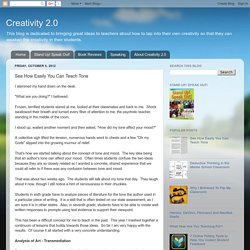
"What are you doing?
" I bellowed. Frozen, terrified students stared at me, looked at their classmates and back to me. Shock swallowed their breath and turned every fiber of attention to me, the psychotic teacher, standing in the middle of the room. I stood up, waited another moment and then asked, "How did my tone affect your mood?
"
3gTeachingToneandMood.pdf. 40 Excellent Short Stories For Middle School. Differentiate Language Arts: Noting Details. By 6th grade, our reading program’s (Houghton Mifflin) comprehension skills have become a bit basic for most of my gifted students.
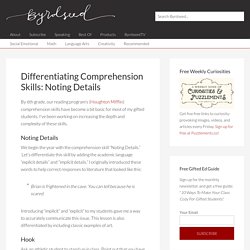
I’ve been working on increasing the depth and complexity of these skills. Noting Details. Teaching Novels In The Common Core Era. The teaching of literature, and novels in particular, has been a subject of some controversy and confusion since the advent of the Common Core.
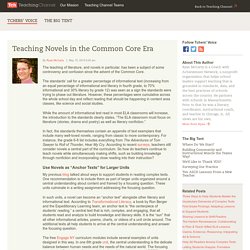
The standards’ call for a greater percentage of informational text (increasing from an equal percentage of informational and literary in fourth grade, to 70% informational and 30% literary by grade 12) was seen as a sign the standards were trying to phase out literature. However, these percentages were cumulative across the whole school day and reflect reading that should be happening in content area classes, like science and social studies. While the amount of informational text read in most ELA classrooms will increase, the introduction to the standards clearly states, “The ELA classroom must focus on literature (stories, drama and poetry) as well as literary nonfiction.” In fact, the standards themselves contain an appendix of text exemplars that include many well-loved novels, ranging from classic to more contemporary.
40 Excellent Short Stories For Middle School. Fire And Ice Poem by Robert Frost - Poem Hunter. Breadloafpoetryexchange [licensed for non-commercial use only] / Identity by Julio Noboa Polanco. Subordinating Conjunction. The Coordinating Conjunction. Use a coordinating conjunction when you want to give equal emphasis to two main clauses.
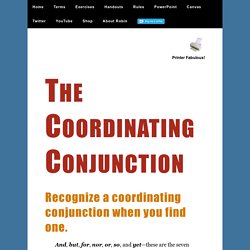
The pattern for coordination looks like this: Subordination, however, emphasizes the idea in the main clause more than the one in the subordinate clause. Generally, the patterns look like these:
FIGURATIVE LANGUAGE IN THE CALL OF THE WILD - COMMON CORE L.5 - DON'T NEED BOOK. <div class="deployment_message_block"><span> Hi, You need to enable javascript on your browser to use TpT.
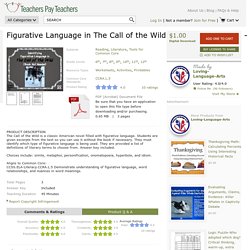
<a href=" target="_blank">See how this improves your TpT experience</a>. </span></div> About Us | Blog | FAQs & Help All Categories Cart Your shopping cart is empty. THE CALL OF THE WILD sample. The Call Of The Wild- Figurative Language. Figurative Language - Call of the wild analysis project. Tone and Mood. The tone and mood words listed below are also available as a Word document.
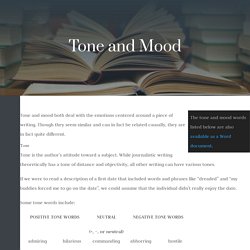
Tone and mood both deal with the emotions centered around a piece of writing. Though they seem similar and can in fact be related causally, they are in fact quite different.
Tone - Examples and Definition of Tone. Tone Definition Tone, in written composition, is an attitude of a writer toward a subject or an audience.
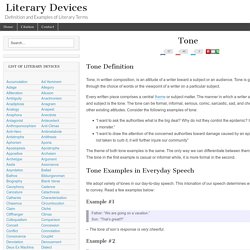
Tone is generally conveyed through the choice of words or the viewpoint of a writer on a particular subject. Every written piece comprises a central theme or subject matter.
Tone (literature)
All pieces of literature, even official documents and technical documents, have some sort of tone.
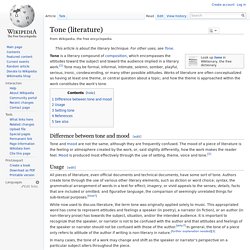
Authors create tone through the use of various other literary elements, such as diction or word choice; syntax, the grammatical arrangement of words in a text for effect; imagery, or vivid appeals to the senses; details, facts that are included or omitted; and figurative language, the comparison of seemingly unrelated things for sub-textual purposes.
[how?] While now used to discuss literature, the term tone was originally applied solely to music. This appropriated word has come to represent attitudes and feelings a speaker (in poetry), a narrator (in fiction), or an author (in non-literary prose) has towards the subject, situation, and/or the intended audience.
Tone Examples. Tone gives shape and life to literature, because it is through tone that the attitude and mood of a work are created and presented. Tone gives voice to the characters, both literally and figuratively.
Through tone, the reader is able to learn about a character's personality and disposition.
Tone in literature. How to Analyze Tone in Literature: 5 Steps. Steps Part 1 Recognizing Common Tones in Literature <img alt="Image titled Analyze Tone in Literature Step 1" src=" width="728" height="546" class="whcdn" onload="WH.performance.clearMarks('image1_rendered'); WH.performance.mark('image1_rendered');">1Notice if the tone is solemn or gloomy.
Figurative Language. English-Zone.Com. English and Language Arts. 150%20841%20X0000049MZP.










